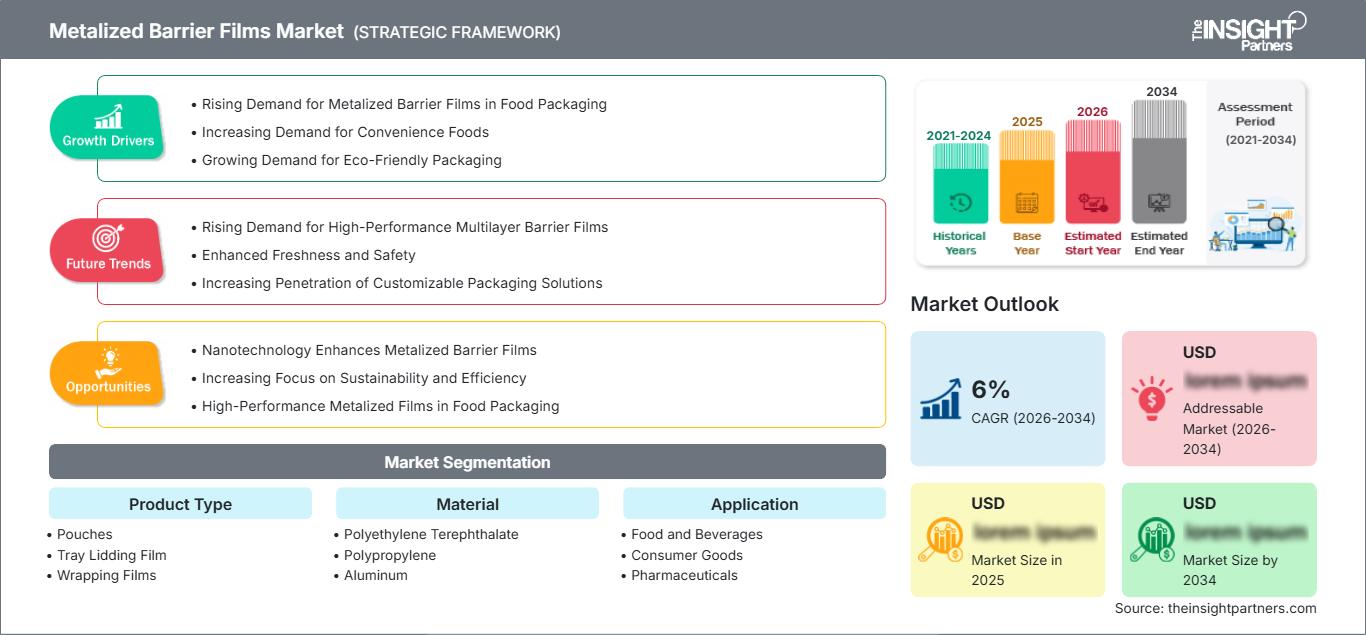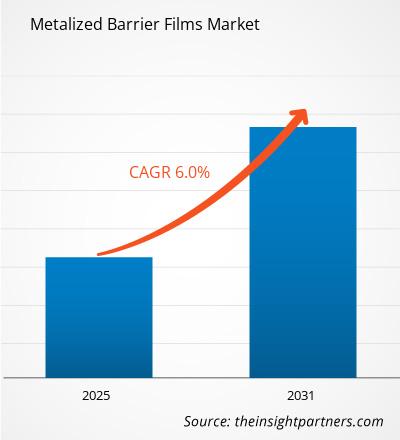Si prevede che il mercato dei film barriera metallizzati crescerà a un CAGR del 6% dal 2026 al 2034. Le condizioni di mercato continuano a evolversi, aprendo nuove opportunità per gli stakeholder. Il panorama generale riflette un progresso stabile e un potenziale di crescita a lungo termine.
Il rapporto presenta un'analisi basata sulla tipologia di prodotto (buste, film di copertura per vassoi, film di confezionamento e blister). Il rapporto è segmentato per materiale (polietilene tereftalato (PET), polipropilene, alluminio, polietilene (PE) e nylon). Il rapporto è segmentato per applicazione (alimenti e bevande, beni di consumo, prodotti farmaceutici, cosmetici e altri). L'analisi globale è ulteriormente suddivisa a livello regionale e per i principali paesi. Le dimensioni e le previsioni del mercato a livello globale, regionale e nazionale per tutti i principali segmenti di mercato sono trattate nell'ambito di applicazione. Il rapporto fornisce il valore in USD per l'analisi e i segmenti sopra indicati. Il rapporto fornisce statistiche chiave sullo stato del mercato dei principali attori e offre tendenze e opportunità di mercato.
Scopo del rapporto
Il rapporto "Metalized Barrier Films Market" di The Insight Partners mira a descrivere il panorama attuale e la crescita futura, i principali fattori trainanti, le sfide e le opportunità. Ciò fornirà spunti a vari stakeholder aziendali, come:
- Fornitori/Produttori di tecnologia: per comprendere le dinamiche di mercato in evoluzione e conoscere le potenziali opportunità di crescita, consentendo loro di prendere decisioni strategiche informate.
- Investitori: per condurre un'analisi completa delle tendenze in merito al tasso di crescita del mercato, alle proiezioni finanziarie di mercato e alle opportunità esistenti lungo la catena del valore.
- Enti di regolamentazione: per regolamentare le politiche e le attività di controllo sul mercato con l'obiettivo di ridurre al minimo gli abusi, preservare la fiducia degli investitori e sostenere l'integrità e la stabilità del mercato.
Segmentazione del mercato dei film barriera metallizzati Tipo di prodotto
- Buste
- Film di copertura per vassoi
- Film di avvolgimento
- Confezioni blister
Materiale
- Polietilene tereftalato
- Polipropilene
- Alluminio
- Polietilene
- Nylon
Applicazione
- Alimenti e bevande
- Beni di consumo
- Prodotti farmaceutici
- Cosmetici
- Altri
Geografia
- Nord America
- Europa
- Asia-Pacifico
- Sud e Centro America
- Medio Oriente e Africa
Potrai personalizzare gratuitamente qualsiasi rapporto, comprese parti di questo rapporto, o analisi a livello di paese, pacchetto dati Excel, oltre a usufruire di grandi offerte e sconti per start-up e università
Mercato dei film barriera metallizzati: Approfondimenti strategici

-
Ottieni le principali tendenze chiave del mercato di questo rapporto.Questo campione GRATUITO includerà l'analisi dei dati, che vanno dalle tendenze di mercato alle stime e alle previsioni.
Fattori di crescita del mercato dei film barriera metallizzati
- Crescente domanda di film barriera metallizzati nel confezionamento alimentare: il mercato dei film barriera metallizzati sta registrando una crescita straordinaria, principalmente grazie all'espansione del settore del confezionamento alimentare. Questi film proteggono gli alimenti da umidità, aria e luce. Pertanto, vengono utilizzati nel confezionamento alimentare per aumentarne la durata di conservazione e preservarne la freschezza. La crescente propensione dei consumatori verso alimenti confezionati sta aumentando la domanda di questi film.
- Crescente domanda di cibi pronti: con la crescente popolarità di cibi pronti, snack e prodotti pronti al consumo, i produttori si sono rivolti ai film metallizzati per la protezione degli alimenti. Questi offrono una delle migliori protezioni contro i materiali di imballaggio convenzionali. Utilizzando questi film, i sapori, le consistenze e le qualità nutrizionali degli alimenti vengono mantenuti e non compromessi durante lo stoccaggio o il trasporto. Questa tendenza sta incoraggiando il progresso del mercato.
- Crescente domanda di imballaggi ecocompatibili: D'altro canto, anche il mercato dei film barriera metallizzati si sta orientando verso opzioni di imballaggio sostenibili. Poiché questi film sono ultraleggeri e possono essere facilmente riciclati o riutilizzati, quindi, da un punto di vista ambientale, sono preferiti dai produttori e dai consumatori di alimenti. La crescente attenzione alla sostenibilità nel settore alimentare incoraggerà ulteriormente l'uso di film metallizzati da parte dei produttori.
Tendenze future del mercato dei film barriera metallizzati
- Crescente domanda di film barriera multistrato ad alte prestazioni: Tra le varie tendenze future nel mercato dei film barriera metallizzati, una è quella dei film barriera multistrato ad alte prestazioni. Questi film avanzati si distinguono per la presenza di più strati, ognuno dei quali svolge una specifica funzione protettiva, ad esempio contro ossigeno, umidità e raggi UV. Questa maggiore efficienza attira la domanda da diversi settori.
- Maggiore freschezza e sicurezza: i film multistrato ad alte prestazioni sono particolarmente adatti per il confezionamento di alimenti. Prolungano la durata di vita di prodotti altamente deperibili e mantengono i prodotti alimentari freschi e sicuri più a lungo. Considerando che la domanda dei consumatori di alimenti confezionati di alta qualità e di lunga durata continua a crescere, si prevede che l'uso di film barriera multistrato aumenterà considerevolmente nei prossimi anni.
- Crescente diffusione di soluzioni di imballaggio personalizzabili: i film barriera multistrato ad alte prestazioni offrirebbero maggiore flessibilità nella progettazione degli imballaggi. Infatti, la combinazione di diversi elementi all'interno di un unico film offre un certo grado di versatilità personalizzata; ciò offre maggiori opportunità per lo sviluppo di materiali in grado di soddisfare specifiche esigenze di confezionamento di diverse tipologie di prodotti. Questo di per sé sta ulteriormente stimolando la crescita del mercato dei film barriera metallizzati.
Opportunità di mercato per i film barriera metallizzati
- La nanotecnologia migliora i film barriera metallizzati: il mercato dei film barriera metallizzati, che include la nanotecnologia avanzata, è alimentato da diverse opportunità di crescita. La nanotecnologia ha aperto la strada alla produzione di pellicole con proprietà molto elevate, come maggiore resistenza, migliori prestazioni barriera e migliore resistenza all'umidità, all'ossigeno e ai raggi UV. Questi tipi di pellicole sono comunemente utilizzati negli imballaggi alimentari.
- Maggiore attenzione alla sostenibilità e all'efficienza: la nanotecnologia può essere utilizzata anche per sviluppare rivestimenti ultrasottili che migliorerebbero la funzionalità delle pellicole metallizzate senza comprometterne la flessibilità o la resistenza. La possibilità di ridurre lo spessore del materiale mantenendo le proprietà barriera conferisce a queste pellicole ulteriori vantaggi in termini di costi e di impatto ambientale. È probabile che ciò aumenti la domanda nei settori orientati alla sostenibilità ambientale.
- Film metallizzati ad alte prestazioni negli imballaggi alimentari: la nanotecnologia migliora ulteriormente la durata e le prestazioni delle pellicole metallizzate barriera. Ad esempio, è possibile aggiungere nanoparticelle alle pellicole per migliorarne la resistenza alla perforazione e allo strappo. Ciò ne garantisce la massima idoneità alle applicazioni di imballaggio in cui la protezione dei prodotti è un fattore chiave. Con il crescente interesse dei produttori per gli imballaggi durevoli, l'integrazione della nanotecnologia sarà uno sviluppo imperativo.
Mercato dei film barriera metallizzati
Le tendenze regionali e i fattori che influenzano il mercato dei film barriera metallizzati durante il periodo di previsione sono stati ampiamente spiegati dagli analisti di The Insight Partners. Questa sezione illustra anche i segmenti di mercato e la geografia della gestione delle malattie del ritmo cardiaco in Nord America, Europa, Asia-Pacifico, Medio Oriente e Africa, America meridionale e centrale.
Mercato dei film barriera metallizzati Report Scope
| Attributo del rapporto | Dettagli |
|---|---|
| Dimensioni del mercato in 2025 | US$ XX Million |
| Dimensioni del mercato per 2034 | US$ XX Million |
| CAGR globale (2026 - 2034) | 6% |
| Dati storici | 2021-2024 |
| Periodo di previsione | 2026-2034 |
| Segmenti coperti |
By Tipo di prodotto
|
| Regioni e paesi coperti |
Nord America
|
| Leader di mercato e profili aziendali chiave |
|
Densità degli attori del mercato dei film barriera metallizzati: comprendere il suo impatto sulle dinamiche aziendali
Il mercato dei film barriera metallizzati è in rapida crescita, trainato dalla crescente domanda degli utenti finali, dovuta a fattori quali l'evoluzione delle preferenze dei consumatori, i progressi tecnologici e una maggiore consapevolezza dei vantaggi del prodotto. Con l'aumento della domanda, le aziende stanno ampliando la propria offerta, innovando per soddisfare le esigenze dei consumatori e sfruttando le tendenze emergenti, alimentando ulteriormente la crescita del mercato.

- Ottieni il Mercato dei film barriera metallizzati Panoramica dei principali attori chiave
Punti di forza
- Copertura completa: il rapporto analizza in modo esaustivo prodotti, servizi, tipologie e utenti finali del mercato delle pellicole barriera metallizzate, offrendo una panoramica olistica.
- Analisi degli esperti: il rapporto è redatto sulla base della conoscenza approfondita di esperti e analisti del settore.
- Informazioni aggiornate: il rapporto garantisce la pertinenza aziendale grazie alla copertura di informazioni e dati recenti.
- Opzioni di personalizzazione: questo rapporto può essere personalizzato per soddisfare le esigenze specifiche del cliente e adattarsi in modo appropriato alle strategie aziendali.
Il rapporto di ricerca sul mercato delle pellicole barriera metallizzate può quindi contribuire a guidare il percorso di decodificazione e comprensione dello scenario del settore e delle prospettive di crescita. Sebbene possano esserci alcune preoccupazioni valide, i vantaggi complessivi di questo rapporto tendono a superare gli svantaggi.
- Analisi storica (2 anni), anno base, previsione (7 anni) con CAGR
- Analisi PEST e SWOT
- Valore/volume delle dimensioni del mercato - Globale, Regionale, Nazionale
- Industria e panorama competitivo
- Set di dati Excel
Report recenti
Testimonianze
Motivo dell'acquisto
- Processo decisionale informato
- Comprensione delle dinamiche di mercato
- Analisi competitiva
- Analisi dei clienti
- Previsioni di mercato
- Mitigazione del rischio
- Pianificazione strategica
- Giustificazione degli investimenti
- Identificazione dei mercati emergenti
- Miglioramento delle strategie di marketing
- Aumento dell'efficienza operativa
- Allineamento alle tendenze normative






















 Ottieni un campione gratuito per - Mercato dei film barriera metallizzati
Ottieni un campione gratuito per - Mercato dei film barriera metallizzati